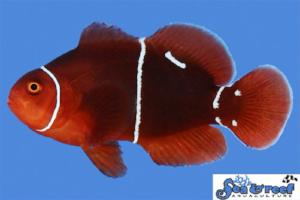Morse Code Maroon Clownfish, Premnas biaculeatus
Approx.. Size Medium 1 1/2"
Max Size 6"
The Morse Code Maroon Clownfish is a variation of the White Stripe Maroon Clownfish. In addition to its 3 white stripes the Morse Code Maroon has unusual white markings in the form of dots and dashes and therefore the name – Morse Code Maroon. Science has come a long way since the scientist and artist Samuel Morse invented the Morse Code in 1836. Each Morse Code Maroon is unique (see picture below). It might seem surprising, but the unusual pattern on the Morse Code Maroon is a naturally occurring color variation. The parent fish were collected from Papua New Guinea (PNG) and have similar unusual Morse Code-like white markings. In fact several white stripe maroon clownfish with unusual patterns have been collected in this area of the Pacific Ocean including the well-known Lightning Maroon Clownfish that was collected by the SEASMART Program. Maroon Clownfish are the largest-sized species of clownfish and can reach a length of 6” as an adult. They belong to the genus Premnas and are therefore different than all the other clownfish species, which belongs to the genus Amphiprion. Premnas is Latin for “spiny cheek” and if you look closely you will see the spines protruding from each side of the head underneath the eyes.
The parent fish to the Morse Code Maroon Clownfish were collected from Papua New Guinea (PNG). Maroon Clownfish have a wide distribution in the Western Pacific Ocean and the Indian Ocean. It can be found west to Sumatra, east to Vanuatu, north to the Philippine Sea and south to New Caledonia.

Temperament & Captive Care
The Maroon Clownfish is the largest known clownfish species and has developed a reputation for their bold behavior. The females can grow to 6” and can be very territorial, especially when defending a nest of eggs. It is best to not mix maroon clownfish with any other clownfish species in your tank and to only keep a mated pair or a single fish. Captive bred Maroon Clownfish are generally less aggressive compared to wild collected fish.
Feeding
Maroon Clownfish have a healthy appetite. Most clownfish are omnivorous feeders, meaning that they will consume a variety of different food types. In nature the diet of clownfish consists of crustaceans (such as copepods and amphipods), algae, polychaete worms and leftovers from the anemone’s meal. Our captive bred fish are conditioned to eat a variety of aquarium diets including pellets, flake food, frozen Mysis shrimp, and frozen brine shrimp.
Natural Host Anemones
In the wild, Maroon Clownfish are very selective and is almost always only found hosting in the Bubble Tip Anemone (Entacmaea quadricolor).
Aquarium Host Anemones
Clownfish do not require host anemones to survive or thrive. However, in most cases they will readily accept them. For Maroon clownfish we recommend the popular and hardy Bubble Tip Anemone (Entacmaea quadricolor).

